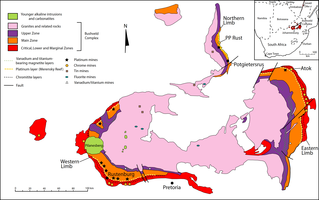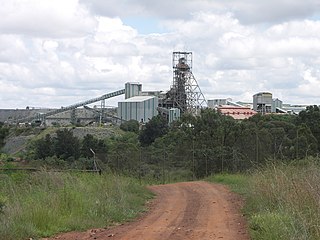
Alfred Beit was an Anglo-German gold and diamond magnate in South Africa, and a major donor and profiteer of infrastructure development on the African continent. He also donated much money to university education and research in several countries, and was the "silent partner" who structured the capital flight from post-Boer War South Africa to Rhodesia. Beit's assets were structured around the so-called Corner House Group, which through its holdings in various companies controlled 37 per cent of the gold produced at the Witwatersrand's goldfields in Johannesburg in 1913.

Barney Barnato was a British Randlord and diamond magnate who was one of the entrepreneurs who gained control of diamond mining, and later, gold mining in South Africa from the 1870s up to World War I. He was known as a rival of Cecil Rhodes.

Boksburg is a city on the East Rand of Gauteng province of South Africa. Gold was discovered in Boksburg in 1887. Boksburg was named after the State Secretary of the South African Republic, W. Eduard Bok. The Main Reef Road linked Boksburg to all the other major mining towns on the Witwatersrand and the Angelo Hotel (1887) was used as a staging post.

Brakpan is a mining town on the East Rand of Gauteng, South Africa, approximately 38 kilometres east of Johannesburg.

Randfontein is a gold mining town in the West Rand, Gauteng, South Africa, 40 km (25 mi) west of Johannesburg. With the Witwatersrand gold rush in full swing, mining financier JB Robinson bought the farm Randfontein and, in 1889, floated the Randfontein Estates Gold Mining Company. The town was established in 1890 to serve the new mine and was administered by Krugersdorp until it became a municipality in 1929. Apart from having the largest stamp mill in the world, Randfontein, like many of the other outlying areas of Johannesburg, is essentially a rural collection of farms and small holdings in a particularly beautiful part of Gauteng.

Rustenburg is a city at the foot of the Magaliesberg mountain range. Rustenburg is the most populous city in North West province, South Africa. In 2017, the city's Gross Domestic Product (GDP) reached ZAR 63.8 billion, accounting for 21.1% of the GDP of the North West Province, and 1.28% of the GDP of South Africa. Rustenburg was one of the official host cities of the 2010 FIFA World Cup, being in close proximity to Phokeng, the capital of the Royal Bafokeng Nation, where the Royal Bafokeng Stadium is located. The England national football team also used this as their base camp for the tournament.
Doornfontein is an inner-city suburb of Johannesburg, South Africa, located to the east of the city centre, Region 8. In the 1930s, it attracted many Jewish immigrants, becoming the main hub for the city's Jewish community. Black African residents, then a minority in the suburb, lived in slum-yards. Under the Slums Clearance Act 1934, the slum-yards were cleared and many residents were relocated to Orlando, Soweto. Since the late 1970s, Doornfontein and other inner-city suburbs of Johannesburg have underdone high levels of white flight to the city's northern suburbs.
Roger Brett Kebble was a South African mining magnate with close links to factions in the ruling political party, the African National Congress. Known to be personally eccentric, he became a major player in South African gold and diamond mining from the mid-1990s, especially through black economic empowerment deals, but was embroiled in allegations of corporate fraud and misconduct, the extent of which was revealed only after his death. He was shot dead on 27 September 2005 in Johannesburg. The investigation into his death, involving several prominent businessmen and politicians, received significant public attention. His name was also prominent in media coverage of Jackie Selebi's 2009 corruption trial. 2010 court testimony revealed that Kebble was killed by hit men hired by his security chief, allegedly at his own request – an apparent suicide-by-murder. However, the complete circumstances surrounding his death remain unclear.

The Bushveld Igneous Complex (BIC) is the largest layered igneous intrusion within the Earth's crust. It has been tilted and eroded forming the outcrops around what appears to be the edge of a great geological basin: the Transvaal Basin. It is approximately two billion years old and is divided into four limbs: northern, eastern, southern and western. It comprises the Rustenburg Layered suite, the Lebowa Granites and the Rooiberg Felsics, that are overlain by the Karoo sediments. The site was first publicised around 1897 by Gustaaf Molengraaff who found the native South African tribes residing in and around the area.
Randlords were the capitalists who controlled the diamond and gold mining industries in South Africa from the 1870s up to World War I.

Solomon Barnato Joel was a British-South African business magnate. He moved to Cape Colony in the 1880s where he made his fortune in connection with diamonds, later becoming a financier with interests in mining, brewing and railways.

Hans Merensky was a South African geologist, prospector, scientist, conservationist and philanthropist.
Asa Resources Group is a mining company based in Johannesburg and London. According to the company's website, it is the first African-owned and African-managed business to be listed in the Resources sector of the London Stock Exchange's Alternative Investment Market. Asa was founded in 1987.

Mining in South Africa was once the main driving force behind the history and development of Africa's most advanced and richest economy. Large-scale and profitable mining started with the discovery of a diamond on the banks of the Orange River in 1867 by Erasmus Jacobs and the subsequent discovery of the Kimberley pipes a few years later. Gold rushes to Pilgrim's Rest and Barberton were precursors to the biggest discovery of all, the Main Reef/Main Reef Leader on Gerhardus Oosthuizen's farm Langlaagte, Portion C, in 1886, which kicked off the Witwatersrand Gold Rush and the subsequent rapid development of the gold field there.

Aquarius Platinum plc is a Bermuda-registered and headquartered mining business.
Uranium production is an important part of the African economy, with Niger, Namibia and South Africa creating up to 18% of the world's annual production. Many African countries produce uranium or have untapped uranium ore deposits.

Impala Platinum Holdings Limited or Implats is a South African holding company that owns several companies which operate mines that produce platinum and platinum group metals, as well as nickel, copper and cobalt. Its most significant mine is the Impala mine in the North West province of South Africa. The company also owns or has interest in the Two Rivers mine and the Marula mine in the South Africa Bushveld Igneous Complex and the Mimosa mine and Zimplats in Zimbabwe, as well as the Impala Refining Services which smelts and refines metals for other companies. In December 2019, Impala Canada was formed, owned by the holding company, out of the acquisition of North American Palladium and its mine in Ontario, Canada.
Steelpoort is a mining town on the R555 road in Sekhukhune District Municipality in the Limpopo province of South Africa. It is located on the border with Mpumalanga province.

Rand Water is a South African water utility that supplies potable water to the Gauteng province and other areas of the country and is the largest water utility in Africa. The water is drawn from numerous sources and is purified and supplied to industry, mining and local municipalities and is also involved in sanitation of waste water.

Sibanye-Stillwater is a multinational mining and metals processing Group with a diverse portfolio of mining and processing operations and projects and investments across five continents. The Group is also one of the foremost global PGM auto catalytic recyclers and has interests in leading mine tailings retreatment operations.












